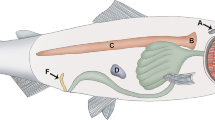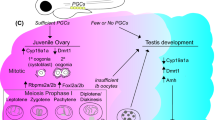Abstract.
Recent research on the circadian system of the zebrafish is reviewed. This teleost has become an attractive model system because of its advantages for genetic analyses. Circadian rhythms of zebrafish behavior, visual system function, and pineal melatonin synthesis have been described, and behavioral and pineal rhythms are being used to identify and characterize clock mutants. Zebrafish heart, kidney, and embryonic cell lines contain circadian oscillators and phototransduction mechanisms for entrainment, suggesting that circadian pacemaking functions may be distributed throughout the animal. Studies of circadian system development in zebrafish have found that a molecular circadian oscillation in unfertilized oocytes persists through embryonic development with its phase intact, but that the pacemakers that drive rhythms of melatonin synthesis and behavior require environmental entraining signals late in development for initial synchronization. Zebrafish homologs of several of the core clock genes identified in other animals have been cloned. Transcripts for most of these are rhythmically expressed in multiple tissues. The interactions of clock gene products are for the most part similar to their interactions in mammals, although there are some potentially interesting differences.
Similar content being viewed by others
Author information
Authors and Affiliations
Additional information
Electronic Publication
Rights and permissions
About this article
Cite this article
Cahill, G.M. Clock mechanisms in zebrafish. Cell Tissue Res 309, 27–34 (2002). https://doi.org/10.1007/s00441-002-0570-7
Received:
Accepted:
Published:
Issue Date:
DOI: https://doi.org/10.1007/s00441-002-0570-7




